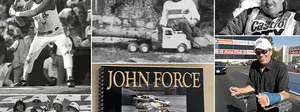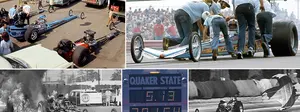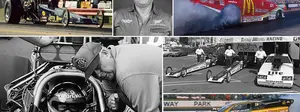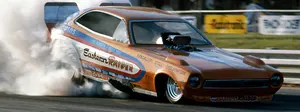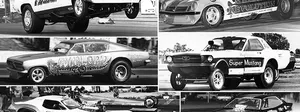

Remembering Doug Nash
 |
It’s one thing to create a legacy doing something and quite another to create two legacies while doing two completely different things, but that’s how Doug Nash will be remembered. Fans of this column certainly will remember Nash for his incredible Bronco Buster Funny Car of the mid-1960s, and many others will remember him for the eponymous transmission units he developed after he left the driver’s seat. We lost Nash July 12 at the age of 73 after a battle with cancer.
Douglas Edwin Nash was born in Detroit, where he attended Garden City High School and developed his love of cars. By 1963, he had found himself behind the wheel of a new 289-equipped Ford Fairlane that ran out of the Dearborn, Mich.-based Bob Ford dealership. According to the book, Total Performers: Ford Drag Racing in the 1960s, the car ran in G/Stock and initially was developed as a test mule for high-performance Ford parts (the car was wrenched by Ernie MacEwan, who was the engine builder for Ford’s Experimental Vehicles Garage). It was not expected to win, built merely to test parts, yet the combination of driver, tuner, and some innovative parts, including a lengthy set of traction bars and some manifold swaps, soon made the car unbeatable, even when it was moved to C/Gas.
 |
Nash’s skills got the attention of the Detroit suits and offered him a Mercury Comet in 1964. The car, which was one of five 289-equipped Comets that Lincoln-Mercury had built that year to show off the engine’s reliability by lapping Daytona Motor Speedway for 100,000 continuous miles at an average speed of 105 mph (and just one of 15 built by the factory that year), was soon converted into a B/FX entry dubbed the Cyclone. It, too, ran amok in its class, capturing several big wins for the marquee and further establishing Nash’s name.
As the FX class that begat Funny Cars began to grow in popularity, Nash jumped in with both feet with one of the sport’s most unusual and well-remembered entries, the Bronco Buster, built around a '66 Ford Bronco. The project, which was “loosely associated” with Ford, mated the unique and boxy body with — what else? — a 289 powerplant bolted into an aluminum chassis. He reportedly was offered one of Ford’s hot new 427 SOHC cammer engines but felt more comfortable with the high-winding 289, but he did have to trade in his favored four-speed transmission for a modified C4 automatic. According to charitable published reports, the car weighed just 1,700 pounds when it debuted in 1966, but there are rumors it weighed much less (around 1,400, with Nash aiming for the 1,200-pound area). Other than being O-ringed and honed and fitted with a cast-aluminum girdle, the 289-cid block was stock, yet it propelled Nash toward the 8.60s and, with the addition of a blower later that year, into the 8.30s at 180 mph. If not for the car’s erratic handling, it may well have gone much quicker.
Here are some good looks at the car, from a car feature shot by Chester Kirk for the February 1967 issue of Drag Strip.
 Looking nothing like the swoopy cars of today — or even yesteryear — Nash's Bronco Buster cut an unusual silhouette. |
 |
 The body was unique, too, in that it was in two parts, as shown, to ease maintenance. Someone somewhere along the line humorously wrote on the back of this photo, "Say, did we tell Doug we put new brakes on his car?" |
 There wasn't a whole lot to the chassis of the Bronco Buster, leading to its light weight. |
 This photo was the center spread for the February 1967 issue of Drag Strip and also used as an inset on the cover. |
 Nash and the Bronco Buster put it to Bob Sullivan's Pandemonium VI Camaro at Michigan's Motor City Dragway. |
 The Bronco Buster was a big draw. Why else would the promoters of the famed Super Stock Nationals pose this photo of Nash, right, handing in his pre-entry form for the event to "the Voice of Drag Racing," Jon Lundberg? |
Nash’s ride soon became a top draw with match race promoters, but it was short-lived, killed off with a double-tap when NHRA outlawed both aluminum chassis and Jeep and pickup-type bodies the following year.
 |
Nash hung up his driving suit and gloves and founded Doug Nash Equipment & Engineering, initially doing prototype engine work for Detroit, before he went on to design and build his now-famous four- and five-speed racing transmissions, known by their straight-cut spur gears and crash shifts. So famous did his transmissions become that General Motors eventually came calling, seeking to put the Doug Nash "4+3" transmission — a four-speed manual coupled to an automatic overdrive on the top with three gears — into its epic C4 Corvette from 1984 to 1988.
After retiring, Nash and his wife, Lesli Diane, traveled extensively in pursuit of vintage model trains and to fish. They retired to the Cayman Islands for several years before returning to the United States, and they settled in the Florida Keys, where they started a boat-rental business with Doug’s brother, Dan.
In addition to his wife and brother, Nash is survived by daughter Noelle, granddaughters Violet and Emmeline, sister Darlene, and a niece and nephew. In his continuing quest to help and benefit others, Doug donated his body to science.
In lieu of flowers, the family asks that donations be made to the American Cancer Society or, due to his love of animals, to any local No-Kill Shelter.
























